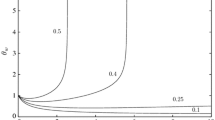Summary
An analysis is presented of the transient heating of a solid wall in the neighborhood of the stagnation point of an air stream impinging at right angles to the wall, when the free-stream temperature of the air is suddenly raised. The two-dimensional air flow is assumed to be incompressible. The temperature of the surface of the wall is obtained by an analysis which includes the variation with time of the air temperature in the boundary layer. The results indicate that for reasonable values of the thermal properties of the air and the wall, one may neglect the unsteady heating of the air and simply use the Nusselt number for steady forced convection in order to analyze the unsteady heat conduction in the wall.
Similar content being viewed by others
Abbreviations
- a n :
-
dimensionless coefficients in (29), see Table II
- c :
-
specific heat of air
- C n :
-
dimensionless coefficients in (16), see Table I
- erfc z :
-
2π −1/2 \(\int\limits_z^\infty {}\)exp(−t 2) dt = complementary error function
- f(η):
-
dimensionless normal velocity
- H :
-
surface film conductance
- h :
-
H/k 1
- k :
-
thermal conductivity
- l :
-
thickness of wall
- L :
-
lH/k 2
- q w :
-
surface heat flux
- Re:
-
real part of
- s :
-
Laplace transform variable
- t :
-
time
- t*:
-
transit time
- T :
-
temperature
- u :
-
velocity component along wall
- U=βx :
-
potential velocity
- v :
-
velocity component normal to wall
- w(z):
-
w 1(x,y=iw 2(x,y) =\({\text{e}}^{ - z^2 } \left( {1 + \frac{{2i}}{{\surd \pi }}\int\limits_0^z {e^{t^2 } } {\text{d}}t} \right)\)
- x :
-
coordinate along wall
- y :
-
coordinate normal to wall
- y 1(t):
-
distance shown in fig. 1
- −α 1, −α 2±iα 3 :
-
roots of (31) in case (a)
- α n :
-
roots of α than α=L in case (b)
- β :
-
parameter of potential flow
- δ :
-
velocity boundary-layer thickness
- δ T :
-
thermal boundary-layer thickness
- Δ :
-
δ T /δ
- ζ :
-
Δ−η
- Δ 1(τ) =−η1 (τ) :
-
dimensionless penetration depth
- η :
-
y/δ
- η 1(τ):
-
y 1(t)/δ
- κ :
-
thermal diffusivity
- λ=βδ 2/ν:
-
7.052
- ν :
-
kinematic viscosity
- σ :
-
Prandtl number of air: ν/κ 1
- τ=βt :
-
dimensionless time variable
- τ*:
-
dimensionless transit time
- χ :
-
χ
- ω :
-
(k 2/k 1)(λσκ 1 κ 2)\(\frac{1}{2}\)
- 0:
-
free-stream conditions
- 1:
-
conditions in boundary layer
- 2:
-
conditions in wall
- w :
-
conditions at surface of wall
References
Goldstein, S. (editor), Modern Developments in Fluid Dynamics, vol. 2, pp. 631–632, Oxford University Press, 1938.
Sparrow, E. M., Unsteady Stagnation-Point Heat Transfer, NASA Technical Note D-77, October 1959.
Schlichting, H., Boundary Layer Theory, first English edition, pp. 70, 206, McGraw-Hill, New York, 1955.
Biot, M. A., Journal of the Aeronautical Sciences 24 (1957) 857.
Staff of the Bateman Manuscript Project, A. Erdélyi, Editor Table of Integral Transforms, vol. 1, McGraw-Hill, New York, 1954.
Carslaw, H. S., and J. C. Jaeger, Conduction of Heat in Solids, Oxford University Press, second edition, 1959.
Author information
Authors and Affiliations
Rights and permissions
About this article
Cite this article
Lyman, F.A. Heat transfer at a stagnation point when the free-stream temperature is suddenly increased. Appl. sci. Res. 13, 65–80 (1964). https://doi.org/10.1007/BF00382038
Received:
Issue Date:
DOI: https://doi.org/10.1007/BF00382038



